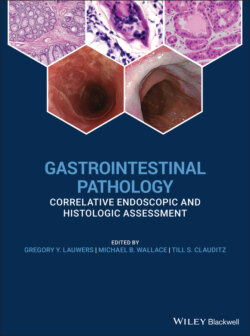Читать книгу Gastrointestinal Pathology - Группа авторов - Страница 85
Differential Diagnosis
ОглавлениеThe differential diagnosis includes disorders that may exhibit histologic epithelial necrosis and/or endoscopic plaques. Candida esophagitis may exhibit similar white plaques endoscopically. Histologically, the plaques appear flaky and less compact, and special stains (GMS, PAS) are diagnostic. Pill‐induced esophagitis is more often associated with nonspecific mucosal ulcers. Corrosive or caustic injury, such as alkali (lye) or acid ingestion, typically shows extensive edema, erythema, and hemorrhage in addition to necrotic exudates. Clinical history is key and the mucosa is seldom biopsied. Esophageal involvement by cutaneous bullous disorders may need to be excluded by immunofluorescence studies for IgG and C3. Severe eosinophilic esophagitis may also exhibit sloughing membranes, but is recognized by the marked intraepithelial eosinophilic infiltration. Black esophagus (i.e. acute esophageal necrosis) is a rare condition that arises in debilitated patients with multiple comorbidities such as hypoperfusion, sepsis, diabetic ketoacidosis, and malignancy. It results from the combining effect of ischemia and corrosive injury of gastric contents. The clinical presentation is distinctive with bleeding and a characteristic diffuse circumferential black mucosal discoloration of the distal esophagus with an abrupt transition at the gastroesophageal junction.
